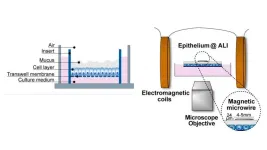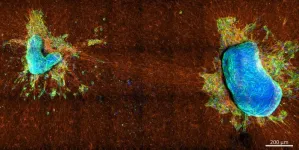(Press-News.org) A recent review article provides critical insights into the management of acute agitation in reproductive-age females and during pregnancy within the emergency departments (EDs). The study emphasizes the importance of considering the safety of psychotropic medications in this demographic population, given the potential risks to both the patient and the fetus.
Agitation in the emergency department is not uncommon and can stem from various causes, including psychiatric disorders, substance abuse, and other medical conditions. When a pregnant patient exhibits signs of agitation, the situation becomes more complex due to potential risks to the fetus. Traditional approaches often involve the use of pharmacological interventions, but the safety of these methods during pregnancy has not been well established.
A new review (DOI: 10.5847/wjem.j.1920-8642.2024.011) in the World Journal of Emergency Medicine explores safer treatment approaches for acute agitation in pregnant patients. Authored by a team from the Department of Emergency Medicine at Jacobi Medical Center and Montefiore Medical Center, the research examines both pharmacological and non-pharmacological methods to manage agitation in reproductive-age females, particularly those who are pregnant.
The research review addresses a critical gap in emergency medical practice: the management of acute agitation in pregnant women. Agitation in this demographic can lead to severe obstetric complications, necessitating prompt and effective treatment. The review's comprehensive literature analysis identifies the complexity of the issue, considering the physiological changes of pregnancy and the potential impact of medications on fetal development. The study emphasizes non-pharmacological approaches as the initial strategy but acknowledges the need for medical intervention in severe cases. Diphenhydramine is highlighted as a preferred choice for mild to moderate agitation due to its sedating effects and minimal adverse outcomes. In more severe cases, high-potency typical antipsychotics, exemplified by haloperidol, are recommended for their hemodynamic neutrality and established safety profile. The review also warns against the use of benzodiazepines and ketamine, which have been linked to negative fetal effects. This research provides a vital guide for emergency physicians, advocating for a balanced approach that maximizes patient safety while minimizing fetal risk. The findings underscore the importance of careful medication selection and dosing to protect both the expectant mother and her unborn child.
Dr. Ariella Gartenberg, the corresponding author of the review from the Department of Emergency Medicine at Jacobi Medical Center and Montefiore Medical Center, NY, USA, states, "The safety of psychotropic medications in reproductive age females has not been well established, and this review aimed to explore general agitation recommendations with an emphasis on ED management during pregnancy."
The findings from this review are crucial for emergency medicine practitioners who must balance the need for effective treatment of acute agitation with the potential risks to the fetus. The study provides recommendations on the use of specific medications during pregnancy.
###
References
DOI
10.5847/wjem.j.1920-8642.2024.011
Original Source URL
https://doi.org/10.5847/wjem.j.1920-8642.2024.011
About World Journal of Emergency Medicine
World Journal of Emergency Medicine (WJEM, ISSN 1920-8642, CN 33-1408/R) is an international peer-reviewed bimonthly journal sponsored by Zhejiang University and the Second Affiliated Hospital of Zhejiang University School of Medicine and published by the Zhejiang University Press. WJEM publishes articles of interest to both clinicians and researchers involving emergency and critical care medicine around world. It focuses on content relevant to clinical practice and research, laboratory studies, medical education about emergency and critical care medicine, including cardiology, internal medicine, general surgery, anesthesiology, orthopedics, and trauma care, and more.
WJEM is now abstracted and indexed in Science Citation Index Expanded (SCIE), PubMed, Pubmed Central, Europe PMC, Scopus, Google Scholar, Gale, ProQuest, Index Copernicus, Zetoc, Chemical Abstracts, VINITI database, EMBASE and EMCare, EBSCO, Ulrich's Peridicals Directory, J-Gate, Reprints Desk, CNKI (China National Knowledge Infrastructure).
END
Navigating the risks: safeguarding maternal and fetal health in emergency agitation treatment
2024-05-07
ELSE PRESS RELEASES FROM THIS DATE:
Telehealth program created to improve access to specialty care found to reduce reliance on opioids in pain management
2024-05-07
COLUMBIA, Mo. (May 7, 2024) ― More Americans suffer from chronic pain than diabetes, heart disease, and cancer combined. Yet, a shortage of pain medicine specialists persists, causing many pain sufferers to seek care in primary care settings.
Researchers from the University of Missouri School of Medicine have found that an innovative tele-mentoring program can help address reliance on opioids in the management of pain, with potential benefits for patients, families and communities.
Project Extension for Community Healthcare Outcomes (ECHO) is an innovative educational and mentoring model where ...
Advancing satellite-based PNT service: low earth orbit satellite constellations augment the GNSS
2024-05-07
A study has outlined the critical needs and essential technologies for a Low Earth Orbit (LEO) constellation to augment satellite navigation systems, significantly improving the Positioning, Navigation and Timing (PNT) services. This research specifically targets the diverse demands of different users for LEO augmented GNSS, the possible contribution of LEOs to PNT performances, and the key technologies referring to the LEO-based navigation augmentation system.
The Global Navigation Satellite Systems (GNSS), including the BeiDou Navigation Satellite System (BDS), are the most widely used in providing PNT services. However, GNSS signals from geostationary orbit (GEO), inclined ...
Researchers show that slow-moving earthquakes are controlled by rock permeability
2024-05-07
Earthquakes are the most dramatic and noteworthy results of tectonic plate movement. They are often destructive and deadly, or at the very least physically felt — they’re literally groundbreaking geological events. However not all tectonic movement results in effects that humans can perceive.
Slow slip events occur when pent up tectonic forces are released over the course of a few days or months, like an earthquake unfolding in slow motion. The more gradual movement means people won’t feel the earth shaking beneath their feet and buildings won’t collapse. But the lack of destruction does not make slow slip events less scientifically ...
Seeking medical insights in the physics of mucus
2024-05-07
WASHINGTON, May 7, 2024 – As much as we might not want to think about it, mucus is everywhere in our bodies. It coats our airways and our digestive systems and serves as a first line of defense against pathogens, a habitat for our microbiomes, and a conveyor belt for our insides to keep everything moving smoothly.
The front-line role of mucus means it is often the site of the first symptoms of infection or disease. Understanding how mucus changes, and what it changes in response to, can help diagnose illnesses and develop treatments. Designing a study to measure the physical properties of mucus, however, is nothing to sneeze at.
In APL Bioengineering, by AIP Publishing, ...
Study sheds light on cancer cell ‘tug-of-war’
2024-05-07
WASHINGTON, May 7, 2024 – Understanding how cancerous cells spread from a primary tumor is important for any number of reasons, including determining the aggressiveness of the disease itself. The movement of cells into the extracellular matrix (ECM) of neighboring tissue is an essential step in cancer progression that directly correlates to the onset of metastasis.
In APL Bioengineering, by AIP Publishing, a team of researchers from Germany and Spain used a breast cancer cell line panel and primary tumor explants from breast and cervical cancer patients to ...
Social determinants of health and the availability of cancer clinical trials in the US
2024-05-07
About The Study: Substantial geographic disparities in cancer clinical trials availability exist throughout the United States, with the most socially vulnerable counties being far less likely to have any trial and having only a fraction of trials available, a disparity that has worsened over time.
Corresponding Author: To contact the corresponding author, Rishi Robert Sekar, M.D., M.S., email rsekar@med.umich.edu.
To access the embargoed study: Visit our For The Media website at this link https://media.jamanetwork.com/
(doi:10.1001/jamanetworkopen.2024.10162)
Editor’s Note: Please ...
Multilevel characteristics of cumulative symptom burden in young survivors of childhood cancer
2024-05-07
About The Study: The findings of this study suggest that symptoms are prevalent years after young childhood cancer survivors’ initial cancer diagnosis, and interventions to reduce caregiver anxiety and neighborhood adversity and improve resilience may alleviate symptom burden.
Corresponding Author: To contact the corresponding author, I-Chan Huang, Ph.D., email i-chan.huang@stjude.org.
To access the embargoed study: Visit our For The Media website at this link https://media.jamanetwork.com/
(doi:10.1001/jamanetworkopen.2024.10145)
Editor’s Note: Please see the article for additional information, ...
Why getting in touch with our ‘gerbil brain’ could help machines listen better
2024-05-07
Macquarie University researchers have debunked a 75-year-old theory about how humans determine where sounds are coming from, and it could unlock the secret to creating a next generation of more adaptable and efficient hearing devices ranging from hearing aids to smartphones.
In the 1940s, an engineering model was developed to explain how humans can locate a sound source based on differences of just a few tens of millionths of a second in when the sound reaches each ear.
This model worked on the theory that we must ...
It flickers, then it tips – study identifies early warning signals for the end of the African humid period
2024-05-07
The transition from the African Humid Period (AHP) to dry conditions in North Africa is the clearest example of climate tipping points in recent geological history. They occur when small perturbations trigger a large, non-linear response in the system and shift the climate to a different future state, usually with dramatic consequences for the biosphere. That was also the case in North Africa, where the grasslands, forests, and lakes favored by humans disappeared, causing them to retreat to areas like the mountains, oases, and the Nile Delta. This ...
Aquatic weed among ‘world’s worst’ expands in Northeastern US
2024-05-07
WESTMINSTER, Colorado – 7 May 2024 – An article in the latest issue of Invasive Plant Science and Management provides new insights on a northern hydrilla (Hydrilla verticillata) subspecies (lithuanica) and its establishment outside the Connecticut River. Considered among the “world’s worst” aquatic weeds, northern hydrilla hinders recreational activities by forming dense canopies. If unchecked, it has the potential to displace native species and host a bacterium that produces ...




